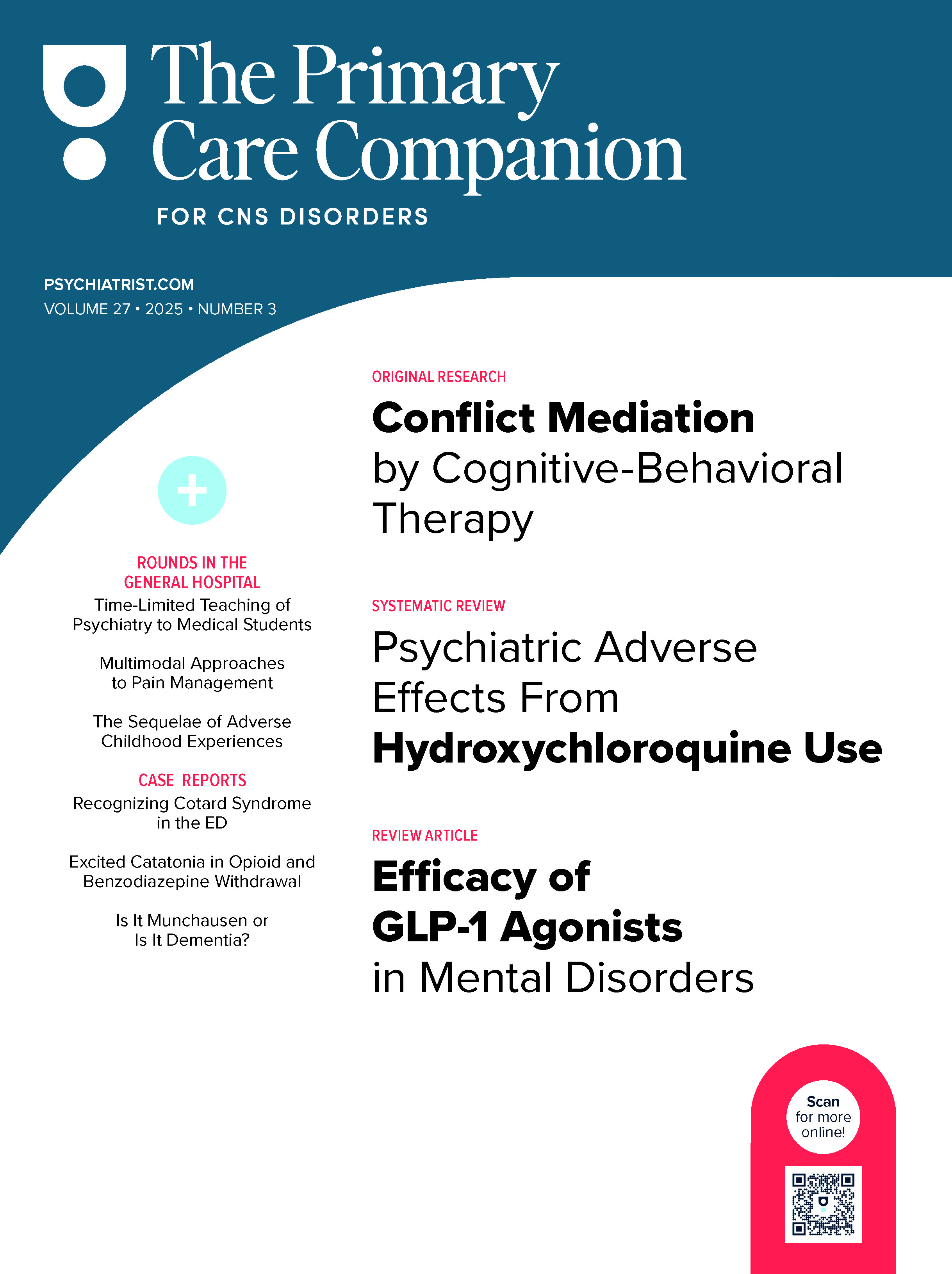To the Editor: First and foremost, depression is not part and parcel of normal aging given the ubiquity of losses seen in old age. Geriatric depression generally encompasses 2 distinctive phenotypes: late onset with an index episode after the age of 50 or 60 years (arbitrarily) and early onset, describing aging patients whose depression initially presented in earlier life. Geriatric depression continues to show a female preponderance, with higher rates in hospital-based and residential care versus community based samples. These rates are overinflated if subsyndromal depressive symptoms are included. Failure to capture these subthreshold symptoms negatively impacts prognostication. Compared to early-onset depression, the late onset phenotype has some qualitative differences. Late-onset depression commonly presents with more apathy and anhedonia than dysphoria.1 Somatization is overrepresented (depressive equivalent or masked depression). Anxiety and psychomotor agitation are highly comorbid. Mood congruent psychotic features consistent with themes of ill health (eg, délire de négation généralisée of Cotard) are classic2 and tally with the historical designation of involutional melancholia. Structural brain changes (especially white matter hyperintensities [WMHs]) are commonplace (vascular depression with executive dysfunction and frontal-subcortical dysconnectivity3). It is typically compounded by medical (chronic inflammatory medical diseases) multimorbidity (bidirectional relationship) and cognitive impairments (whether depressive pseudodementia, prodrome of dementing process, independent risk factor for dementia, or true comorbidity). All this speaks to a heightened suicidality4 (with high completers to attempters ratio). While genetic contribution is less pronounced in the late-onset phenotype, proximal stressors abound (adverse life events), as is the case with high neuroticism scores. Late phenotype tends to recur and run a chronic course.
Workup should begin with a depression screener (eg, Patient Health Questionnaire-95 or Geriatric Depression Scale6). Psychiatric history of past depressive episodes, genetic load, exit events, antidepressant drug history, substance use, social network, and functional status should be avidly obtained and better corroborated by collaterals. Suicide risk (ideas, intent, and plans current or past and protective vectors) needs to be explored in depth, including access to firearms. Cognitive assessment follows using the Mini-Mental State Examination7 or Montreal Cognitive Assessment.8 Medical history is crucial, emphasizing physical limitations and chronic pain syndromes, listing prescribed (and nonprescribed) medications with a special attention to nutritional status. This should be complemented with a physical examination, particularly a neurological examination, and fine-tuned by laboratory studies as indicated, especially serum thyroid-stimulating hormone, red cell folate, vitamin B12, and vitamin D. Some have advocated polysomnography for underlying sleep disorders.
For mild to moderate major depressive disorder, structured, time-limited, and manualized psychotherapies (cognitive behavioral therapy, interpersonal therapy, and problem-solving therapy) have been demonstrated to be effective. Psychopharmacotherapy choice depends largely on tolerability and safety, prior response, drug-drug interactions, medical comorbidities, cost, and patient preference. “Start low, go slow, but go!” as different pharmacokinetics dictate (↑volume of distribution, ↑blood-brain barrier permeability, ↓renal clearance, etc). Response rate is typically cited similar to that of the younger population (60%) but can be slower (longer treatment trials of 10–12 weeks might be warranted). Selective serotonin reuptake inhibitors (SSRIs) are first-line options on guidelines. Extra caution should be exercised when prescribing SSRIs in older age patients due to the associated increased risk of falls, syndrome of inappropriate secretion of antidiuretic hormone (hyponatremia), and gastrointestinal bleeding (proton pump inhibitors are commonly co-prescribed).9,10 Presence of vascular risk, WMHs, or executive dysfunction generally portends a poor response to SSRIs. Paroxetine is better avoided for anticholinergicity11,12 and citalopram for a potential to prolong QTc interval.13 Bupropion14 is said to be helpful notably for vascular depression and mirtazapine15 for melancholic depression with prominent neurovegetative symptoms of insomnia and anorexia. Generally, augment for partial response (eg, aripiprazole, but beware of black-box warning in demented patients) and switch for nonresponse (eg, serotonin norepinephrine reuptake inhibitors). Since relapses are common, prophylaxis for 1–2 years is strongly recommended.
For treatment-resistant16 and severe cases, suicidality, refusal of oral intake, psychotic depression, catatonia, or psychopharmacotherapy intolerability, electroconvulsive therapy (ECT) is strongly indicated, with no absolute contraindications and reported higher efficacy in the older population. Anticognitive downsides remain a concern, though.17 Again, WMHs, chronicity, social isolation, anxiety, physical limitations, and poverty have been reported to predict a poor response to ECT. Lack of required anesthesia and benign cognitive safety profile might favor repetitive transcranial magnetic stimulation over ECT, but further evidence is needed. Comprehensive management should engage the patient’s caregivers or family and foster a multipronged approach, while being attuned to care burden and distress, which can invoke depression in themselves.
Geriatric depression is not uncommon and is heterogeneous, associated with significant morbidity and functional impairment, higher health care costs, heightened suicide, and premature mortality.18 It behooves clinicians to be vigilant to screen for it and to have a low threshold to treat it.
Article Information
Published Online: May 16, 2024. https://doi.org/10.4088/PCC.23lr03686
© 2024 Physicians Postgraduate Press, Inc.
Prim Care Companion CNS Disord 2024;26(3):23lr03686
Submitted: December 16, 2023; accepted January 19, 2024.
To Cite: Naguy A, Al-Khadhari S. Geriatric depression: what do clinicians need to know?
Prim Care Companion CNS Disord. 2024;26(3):23lr03686.
Author Affiliations: Department of Psychiatry, Kuwait Centre for Mental Health, Shuwaikh, Kuwait (Naguy); Department of Psychiatry, Faculty of Medicine, Kuwait City, Kuwait (Al Khadhari).
Corresponding Author: Ahmed Naguy, MBBch, MSc, MRCPsych (UK), Kuwait Centre for Mental Health, Jamal Abdul-Nassir St, Shuwaikh, Kuwait ([email protected]).
Relevant Financial Relationships: None.
Funding/Support: None.
ORCID: Ahmed Naguy: https://orcid.org/0000-0002-6465-456X
References (18)

- Naguy A, Alwetayan S, AlKhadhari S. Anhedonia as a transdiagnostic construct. Asian J Psychiatr. 2020;48:101604. PubMed CrossRef
- Naguy A. Eponymous psychiatric syndromes revisited. Prim Care Companion CNS Disord. 2018;20(1):17br02195. PubMed CrossRef
- Naguy A, Sabir S. A vascular approach to bipolar mood disorder. Prim Care Companion CNS Disord. 2022;24(5):21brr03232.
- Naguy A, Elbadry H, Salem H. Suicide: a précis! J Fam Med Prim Care. 2020;9(8):4009–4015.
- Kroenke K, Spitzer RL, Williams JB. The PHQ-9: validity of a brief depression severity measure. J Gen Intern Med. 2001;16(9):606–613. PubMed CrossRef
- Yesavage JA. Geriatric Depression Scale. Psychopharmacol Bull. 1988;24(4):709–711. PubMed
- Folstein MF, Folstein SE, McHugh PR. ‘Mini-mental state’: a practical method for grading the cognitive state of patients for the clinician. J Psychiatr Res. 1975;12(3):189–198. PubMed CrossRef
- Nasreddine ZS, Phillips NA, Bédirian V, et al. The Montreal Cognitive Assessment, MoCA: a brief screening tool for mild cognitive impairment. J Am Geriatr Soc. 2005;53(4):695–699. PubMed CrossRef
- Naguy A, Singh A, AlDarweesh FQM, et al. Possible toxic serotonin syndrome in an adolescent with obsessive-compulsive disorder precipitated by esomeprazole. Prim Care Companion CNS Disord. 2022;24(4):21cr03096. PubMed CrossRef
- Moodliar S, Naguy A, AlKhadhari S. Vortioxetine related Call-Fleming syndrome. Am J Ther. 2019;28(2):e258–e260. PubMed CrossRef
- Naguy A. Paroxetine: into oblivion? Prim Care Companion CNS Disord. 2018;20(1):17l02113. PubMed CrossRef
- Naguy A. Paroxetine: into oblivion? Well, guess not. Prim Care Companion CNS Disord. 2019;21(2):18l02369. PubMed CrossRef
- Naguy A. Psychotropic drugs and prolonged QTc interval: does it really that matter? Indian J Psychol Med. 2016;38(2):165–166. PubMed CrossRef
- Naguy A, Badr BHM. Bupropion-myth-busting! CNS Spectr. 2022;27(5):545–546. PubMed CrossRef
- Naguy A. Mirtazapine for major depression developed after hyperemesis gravidarum. Am J Ther. 2019;26(5):e661–e662. PubMed CrossRef
- Naguy A, Alamiri B, AlAwadhi DS. Treatment resistant depression: a plea to mull over! Asian J Psychiatr. 2018;36:69–70. PubMed CrossRef
- Naguy A, Alkhadhari S. ECT and cognition–truism or tautology? Asian J Psychiatr. 2021;66:102879. PubMed CrossRef
- Gundersen E, Bensadon B. Geriatric depression. Prim Care. 2023;50(1):143–158. PubMed CrossRef
Please sign in or purchase this PDF for $40.




